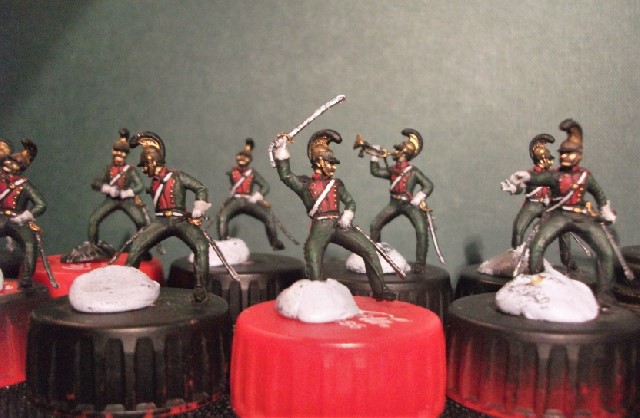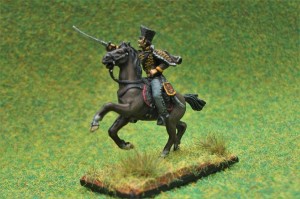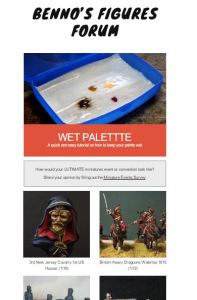KAMAR of Germany supply a great range of 1:72 scale figures including their own range of figures ranging from the Viking era to WWII. They also stock other manufacturers including Phersu’s ancients and Stenfalk’s magnificent animal range, to name but two. From KAMAR, I ordered this small group of four 1815 Dutch Carabiniers in metal, thinking, that despite their small number, they might make for a pleasing and unusual addition to the Nappy Cavalry Project.
These figures are supposed to depict the Dutch Carabiniers dating specifically from 1815, referring to their part in the 100 Days campaign and the battle of Waterloo. They were part of Tripp’s Heavy Cavalry Brigade at Waterloo which consisted of three regiments from the Netherlands:
- 1st Dutch Carabiniers (pink facings and red turnbacks)
- 2nd Belgian Carabiniers (red facings)
- 3rd Dutch Carabiniers (yellow facings)
I’ve elected to represent the 1st regiment which wore the unusual pink facings. Across the internet, it appears that there is some confusion over the headdress worn by these Dutch Carabiniers during the Waterloo campaign. It seems that most sources depict both the 1st and 3rd Dutch Carabiniers wearing bicornes whilst their Belgian comrades in the 2nd Belgian Carabiniers wore steel dragoon helmets.

In my copy of the ever-reliable The Waterloo Companion, however, Mark Adkin actually has the 1st Dutch Carabiniers wearing the steel helmet and this is further depicted in one the book’s plates.

Eventually, I discovered a comment from a blogger which might offer an explanation for all the confusion. This blogger suggests that;
“…the uniform with the bicorne and long tailed and lapeled coat was prescribed by the Souvereign Order of 31st December 1813. The regulations of 9 January 1815 ordered a short tailed single breasted coatee and the Belgian (steel) helmet. They were to be fully implemented on 1st May 1816. So both regiments went to war in 1815 in the old uniforms.”
So, it’s probable that KAMAR’s figures are suitable for Waterloo. Incidentally, the Italian manufacturer, Waterloo 1815, have produced a set of 6 metal / resin Belgian Carabiniers with steel helmets and which would compliment my Dutchmen very nicely. Well, I suppose I might consider a purchase…
There’s plenty of colour to paint in this regiment; pink, blue, red and white and you may also notice that these troops wear an orange cockade in their bicornes, in recognition of the Dutch Royal House. I think the most pleasing aspects of the figures is their relaxed state, swords drawn but otherwise passive with their standing horses nonetheless looking pleasingly animated and alive.
To conclude, some pictures of my first metal figures in the 1:72 scale Napoleonic Cavalry Project, followed by a brief regimental biography:








Regimental Biography: The 1st Dutch Carabiniers and Waterloo
During the Waterloo Campaign, the 1st Dutch Carabiniers were part of the Dutch Heavy Cavalry Brigade under Maj-General Tripp. The regiment numbered 446 sabres across 3 squadrons and in command was Lt-Col Coenegracht.
They were initially held in reserve behind Wellington’s centre. However, after the Household Brigade had been badly mauled in their epic counter-charge against the main French infantry assault, Tripp’s heavy cavalry became the only intact heavy cavalry formation left to Wellington. Consequently, they were heavily engaged against the French Cavalry for the remainder of the afternoon.

The Dutch Carabiniers initially counter-charged the French Cuirassiers which had been pursuing the remnants of the Household Brigade. A fierce melee ensued until the French were forced to withdraw.
As the battle continued, the 1st Dutch Carabiniers were called upon to counterattack on a number of occasions costing them 102 casualties (25% of the regiment) including a number of their senior officers including Lt.Col. Coenegracht himself, who was mortally wounded.

A flavour of the exhausting and bloody nature of the fighting experienced by the 1st Dutch Carabiniers at Waterloo can be gleaned from this quote by Maj-General Jonkheer (respectfully reproduced from the brilliant General Picton blog):
“After resting in this position, I noticed enemy’s cuirassiers which were advancing to charge the English squares. I saw a perfect moment to charge the enemy and ordered the 1st Regiment of Carabiniers attack the enemy as they were disordered around the squares. After the charge there were numerous enemies dead and wounded left on the ground. At the moment when the 1st Regiment rallied, the enemy sent in a second charge, in this action there were more than one French cuirassier regiment. These were equally repulsed by the 2nd and 3rd Regiment, many cuirassiers were left in our hands.”
















































































